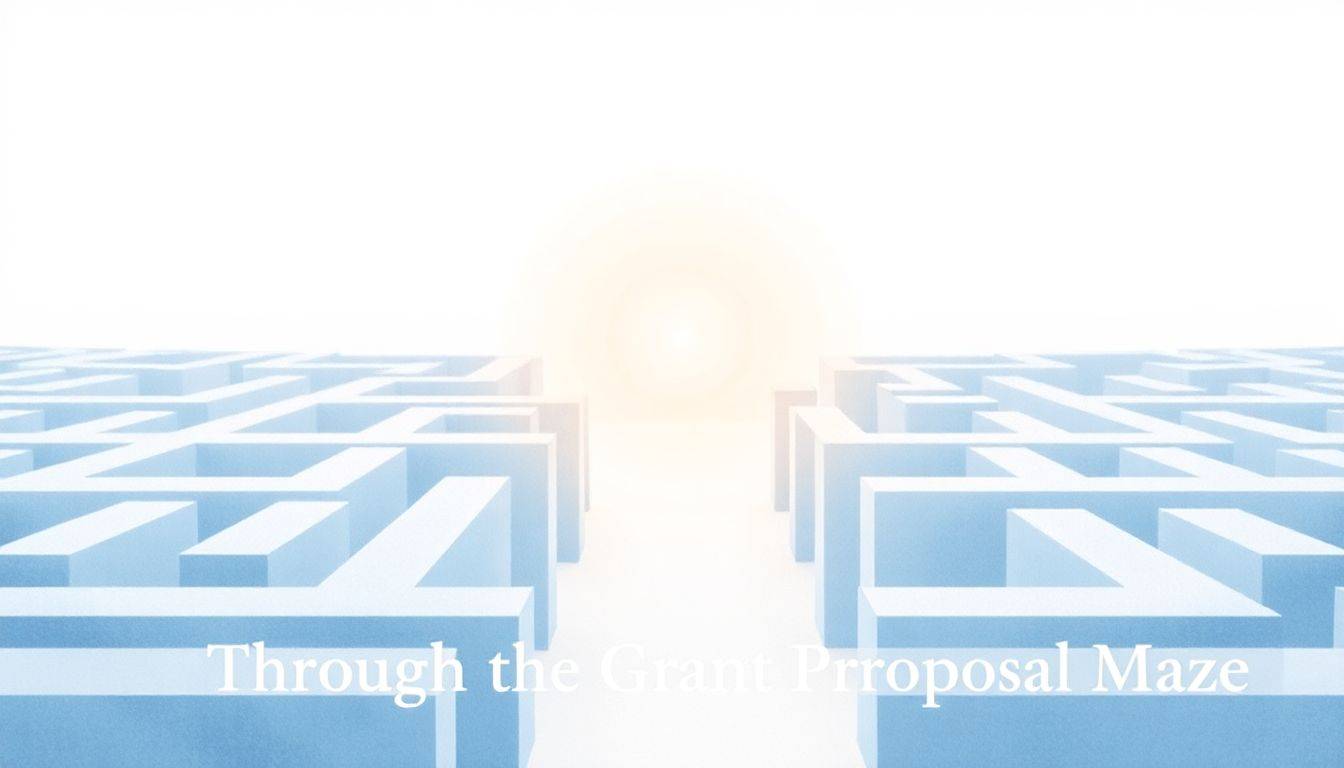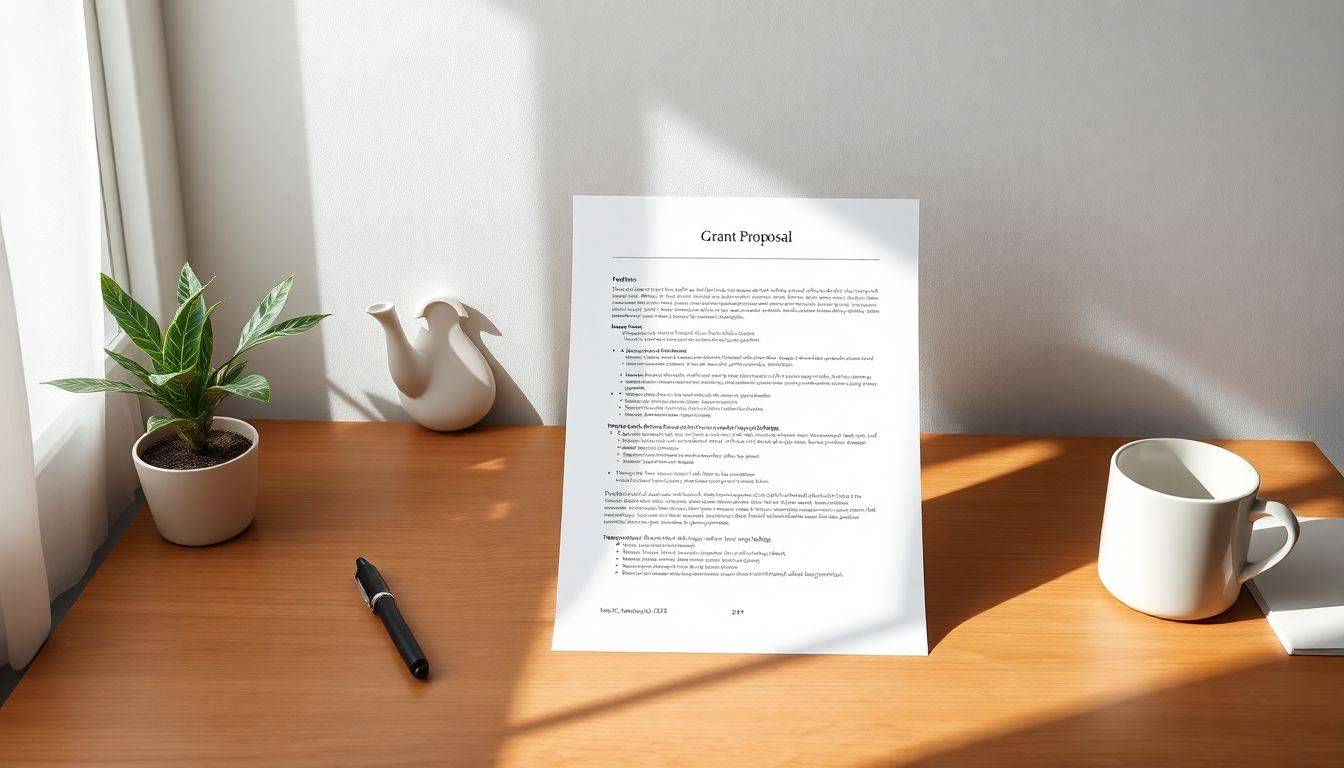Writing a grant proposal can feel like navigating a maze, can’t it? You’re not alone if you’re feeling overwhelmed by where to start and what to include.
But don’t worry, we’ve got your back! In this guide, we’ll walk you through each step, making the process as straightforward as possible.
From understanding the granting agency to crafting a strong cover letter and setting SMART goals, we’ll cover everything you need to create a compelling grant proposal.
Key Takeaways
- Start by finding grants that align with your project’s goals to boost your chances of success.
- Understand the granting agency’s mission and tailor your proposal to match their priorities.
- Prepare necessary documents and set SMART goals to clarify your project’s objectives.
- Write a concise cover letter and executive summary that clearly introduce your project.
- Structure your proposal clearly, include supporting data, and highlight your team’s qualifications.
- Create a detailed, realistic budget and thoroughly review your proposal before submission.
- Be persistent; applying for multiple grants significantly increases your chances of success.

1. How to Write a Grant Proposal: Step-by-Step Guide
Writing a grant proposal can feel overwhelming, but breaking it down into clear steps makes the process manageable. Start by identifying grants that align with your project’s goals. Thorough research is essential because only about 1 in 10 grant proposals is accepted. However, applying for three to five grants can increase your chances of success to about 90%.
Here’s a simple guide to help you craft a compelling proposal:
- Research Potential Grants: Look for grants that match your project’s focus and objectives.
- Understand the Granting Agency: Learn about the organization’s mission and what they fund.
- Prepare Your Proposal: Gather all necessary information and documents before you start writing.
- Write a Strong Cover Letter: Introduce your project and explain why it’s a good fit for the grant.
- Create an Executive Summary: Provide a snapshot of your proposal for quick understanding.
- Develop a Clear Methodology: Explain how you plan to achieve your project goals.
- Include Data and Evidence: Support your proposal with relevant statistics and research.
- Demonstrate Qualifications: Highlight your team’s expertise and past successes.
- Budget Wisely: Present a realistic budget that accounts for all project costs.
- Review and Edit: Proofread your proposal to ensure clarity and professionalism.
Remember, persistence is key. Even if your first proposal isn’t accepted, each attempt hones your skills and brings you closer to success.
2. Understand the Granting Agency
Before putting pen to paper, dive deep into understanding the agency offering the grant. Each granting organization has its own mission, values, and funding priorities. Aligning your proposal with their objectives demonstrates that you’re a suitable candidate for their support.
For instance, the National Endowment for the Humanities (NEH) Public Scholar Program plans to award around 25 grants per deadline, each up to $60,000. Knowing that they focus on humanities projects helps you tailor your proposal to meet their specific interests.
Take the time to read the agency’s guidelines thoroughly. Look at previously funded projects to get a sense of what they value. This research not only helps you customize your proposal but also shows the agency that you’re diligent and committed.
3. Prepare Your Proposal
Preparation sets the foundation for a successful grant proposal. Start by gathering all the necessary documents, such as your organization’s mission statement, resumes of key team members, and letters of support. Having everything organized beforehand saves time and reduces stress.
Outline your proposal to ensure you include all required sections. A typical grant proposal includes a cover letter, executive summary, statement of need, project description, budget, and evaluation plan.
Setting SMART goals—Specific, Measurable, Achievable, Relevant, and Time-bound—helps clarify your project’s objectives. Clearly defined goals make it easier for the granting agency to understand what you aim to accomplish and how you’ll measure success.
Don’t underestimate the importance of supporting data and evidence. Including relevant statistics and research strengthens your proposal by demonstrating the significance of your project. For example, if you’re working on a literacy program, you might reference recent studies on reading levels in your target community.
Using the right tools can also streamline the writing process. Exploring the best word processors for writers can help you format your proposal professionally and keep your content organized.
Finally, consider seeking feedback from colleagues or mentors. An extra pair of eyes can catch errors you might have missed and provide valuable insights to improve your proposal.

4. Write a Strong Cover Letter
Your cover letter is your first chance to make a great impression with the granting agency.
Think of it as a friendly introduction where you highlight the key points of your proposal.
Keep it concise—no more than one page.
Address the letter to the appropriate person, using their name if possible.
In the opening paragraph, briefly introduce your organization and explain how your project aligns with the agency’s goals.
For example, if you’re applying to the NEH Public Scholar Program, mention how your humanities project fits their funding priorities.
Share your enthusiasm for the project and express appreciation for their consideration.
Remember, the cover letter sets the tone for your proposal, so make it engaging and professional.
5. Create an Effective Executive Summary
The executive summary is a snapshot of your entire proposal.
Grant reviewers often read this section first, so it’s crucial to make it clear and compelling.
Summarize the key points: the problem you’re addressing, your project’s objectives, methodology, expected outcomes, and the amount of funding you’re requesting.
Keep it brief—usually one page or less.
Use straightforward language, avoiding jargon or technical terms that might confuse the reader.
Imagine you’re explaining your project to a friend over coffee.
You want them to understand why your project matters and how it will make a difference.
6. Structure Your Proposal Clearly
A well-structured proposal makes it easy for reviewers to understand your project.
Follow the granting agency’s guidelines precisely.
If they provide a template or outline, use it.
Typically, your proposal should include sections like the introduction, statement of need, objectives, methods, evaluation plan, budget, and conclusion.
Use headings and subheadings to organize your content.
Bullet points and numbered lists can help break up dense text and highlight key information.
Clear organization not only enhances readability but also shows that you’re methodical and attentive to detail.
7. Set SMART Goals for Your Project
Setting SMART goals helps clarify what you want to achieve with your project.
SMART stands for Specific, Measurable, Achievable, Relevant, and Time-bound.
For example, instead of saying “Improve literacy rates,” specify “Increase reading proficiency among 200 third-grade students by 15% within one year.”
This goal is specific (increase reading proficiency), measurable (by 15%), achievable (with appropriate resources), relevant (addresses literacy), and time-bound (within one year).
Clearly defined goals make it easier for the granting agency to understand your objectives and evaluate your proposal.
They also provide a roadmap for your project’s implementation and assessment.
8. Develop a Clear Methodology
Your methodology outlines how you’ll achieve your project goals.
Be detailed and specific.
Describe the activities you’ll undertake, the timeline, and the personnel involved.
If you’re running a program, explain what sessions will look like, who will lead them, and how participants will be recruited.
Include any partnerships or collaborations that will enhance your project’s effectiveness.
For complex projects, a Gantt chart or timeline can help visualize the schedule.
Demonstrating a clear plan gives reviewers confidence in your ability to execute the project successfully.
9. Include Data and Evidence
Supporting your proposal with data strengthens your case.
Use relevant statistics, research findings, and case studies to illustrate the need for your project.
For instance, if you’re addressing a health issue, include local health statistics that highlight the problem’s severity.
Grantmakers look for evaluations to determine if the programs they invest in make a difference.
Including evidence of past successes can also be persuasive.
If your organization has previously increased literacy rates by 20%, mention it.
Cite reputable sources and provide references where appropriate.
Using modern AI tools for data analysis can help you gather and interpret relevant statistics more efficiently.
10. Demonstrate Your Qualifications
Granting agencies want to fund organizations that can deliver results.
Highlight your team’s expertise and experience.
Include brief biographies of key personnel, emphasizing relevant skills and accomplishments.
If you’ve successfully managed similar projects or grants, showcase those successes.
Letters of support or testimonials from partners and beneficiaries can add credibility.
Remember, you’re not just selling your project—you’re showing that you’re the right team to execute it.
11. Budget Wisely for Your Proposal
A detailed and realistic budget is crucial.
Break down all the costs associated with your project, including personnel, materials, equipment, travel, and overhead.
Be honest and transparent.
Don’t inflate numbers or underestimate expenses.
Include a budget narrative that explains each line item.
This helps reviewers understand how funds will be used and justifies the costs.
Some grants require matching funds or in-kind contributions—make sure to note these if applicable.
A well-planned budget shows that you’re financially responsible and prepared.
12. Review and Edit Your Proposal
Before submitting, take the time to review and polish your proposal.
Proofread for spelling and grammatical errors.
Consider using one of the best proofreading software tools to catch mistakes you might miss.
Ensure that your ideas flow logically and that the content aligns with the grant’s requirements.
Consider asking a colleague or mentor to read your proposal—they might catch something you missed.
Reading it aloud can also help identify awkward phrasing or unclear sections.
An error-free and professional proposal reflects your attention to detail and dedication.
13. Final Tips for Success
Persistence is key in the grant application process.
Remember that only about 1 in 10 grant proposals is accepted.
Don’t be discouraged by rejection—instead, use feedback to improve your next proposal.
Applying for multiple grants increases your chances of success.
In fact, applying for three to five grants can boost your chances of winning at least one to about 90%.
Stay organized by keeping track of deadlines and requirements for each application.
Using AI tools for small business can help manage your schedule and tasks effectively.
Set reminders for important dates.
Building relationships with grant officers can also be beneficial.
Don’t hesitate to reach out with questions or to seek guidance.
14. Conclusion: Importance of a Strong Grant Proposal
Crafting a strong grant proposal takes time and effort, but it’s a worthwhile investment.
A well-prepared proposal not only increases your chances of securing funding but also clarifies your project’s objectives and methods.
It’s an opportunity to showcase your organization’s potential to make a meaningful impact.
By following these steps and staying persistent, you’re on your way to bringing your project to life.
Remember, every successful grant starts with a compelling story—tell yours with confidence and clarity.
FAQs
A successful grant proposal includes a project summary, clear objectives, a detailed methodology, a justified budget, and evidence of qualifications. Each component should align with the funding agency’s criteria and demonstrate the viability and impact of your project.
Research the agency’s mission statement, funding guidelines, and previously funded projects. This information helps you tailor your proposal to their specific interests and demonstrate how your project aligns with their goals and objectives.
An effective executive summary concisely presents your project’s purpose, objectives, methods, and expected outcomes. It should highlight the significance of your work and how it meets the funding agency’s priorities, capturing the reader’s interest immediately.
Set goals that are Specific, Measurable, Achievable, Relevant, and Time-bound. Clearly define what you aim to accomplish, how you will measure success, ensure the goals are attainable, align them with your project’s purpose, and establish a realistic timeline.
